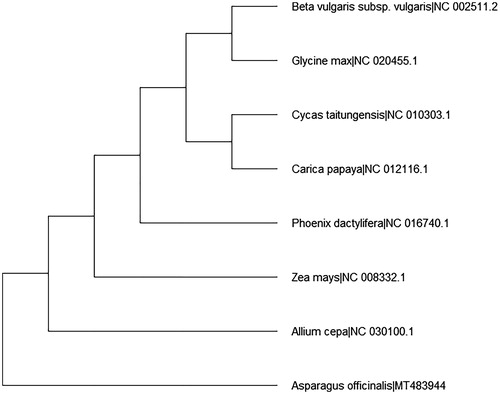Abstract
Asparagus officinalis L. is a horticultural plant in nature and belongs to the genus Asparagus of Asparagaceae family. The complete mitochondrial (mt) genome of A. officinalis was 492,062 bp in length with a 45.9% GC content. A total of 60 genes were annotated including 37 protein-coding genes, 17 tRNA genes, and 6 rRNA genes. Phylogenetic tree analysis using the neighbor-joining method demonstrated that A. officinalis was most closely related to Allium cepa and separated from Beta vulgaris subsp. Vulgaris based on the complete mt genome sequence.
As a horticulture plant with economical and cultural importance, a high-quality reference mitochondrial(mt) genome is currently lacking in Asparagus officinalis L. (Li et al. Citation2019). Phylogenetic analyses of mt DNA genome will be important for reconstructing the systematic classification relationship and genetic diversification studies of this genus. In this study, we sequenced the complete mt genome of Asparagus officinalis L. using a hybrid data of Illumina4000 and PacBio RSII platform, and the mt genome was recovered after de novo assembly and annotation. One gram of tender root from five individuals was sampled from the planting base of Jiangxi Academy of Agricultural Sciences((E115°27′, N28°09′), using the modified CTAB method (Li et al. Citation2013). Total DNA was constructed for the genomic library, then was sequenced and assembled into non-redundant contigs with SPAdes3.6.1 (Bankevich et al. Citation2012) and SOAPdenovo2 (Luo et al. Citation2012). Each contig of the mt genome was screened by Blast run, and was assembled by using Sequencher 5.4.6 (Altschul et al. Citation1997). Primer walking and PacBio sequencing were used to fill the gaps. Mt genome was annotated by using the Dual Organellar GenomeAnnotator (DOGMA) (Wyman et al. Citation2004). The complete mt genome sequence of A. officinalis was 492,062 bp (NCBI accession number: MT483944), with a typical circle structure and a GC content of 45.9%. The genome contains 37 protein-coding genes, including ones for NADH dehydrogenase (nad1, 2, 3, 4, 4 L, 5, 6, 7, 9), cytochrome c oxidase (cox1, 2, 3), cytochrome c biogenesis (ccmB, C, Fn, Fc), apocytochrome b (cob), ATP synthase (atp1, 4, 8, 9), ribosomal proteins (rpl2, 5, 10 and rps1, 3, 4, 7, 10, 12, 13, 19), succinate dehydrogenase (sdh3, 4), maturase and membrane transporter (mttB and matR). Meanwhile, the genome contains 17 tRNA genes and 3 rRNA genes (rrn5, 18, 26). To classify the systematic relationship of A. officinalis, the neighbor-joining phylogenetic tree was constructed using the software MEGA-X based on 8 complete mt genome (https://blast.ncbi.nlm.nih.gov) (Kumar et al. Citation2018). The tree showed a close relationship between A. officinalis and Allium cepa, and it is separated from Beta vulgaris subsp. Vulgaris (). The complete mt genome sequence of A. officinalis can benefit further studies on its systematic classification.
Disclosure statement
No potential conflict of interest was reported by the author(s).
Data availability statement
The data that support the findings of this study are openly available in [Asparagus officinalis] at [https://www.ncbi.nlm.nih.gov/nuccore/ MT483944], reference number [MT483944].
Additional information
Funding
References
- Altschul SF, Madden TL, Schaffer AA, Zhang J, Zhang Z, Miller W, Lipman DJ. 1997. Gapped BLAST and PSI-BLAST: a new generation of protein database search programs. Nucleic Acids Res. 25(17):3389–3402.
- Bankevich A, Nurk S, Antipov D, Gurevich AA, Dvorkin M, Kulikov AS, Lesin VM, Nikolenko SI, Pham S, Prjibelski AD, et al. 2012. SPAdes: a new genome assembly algorithm and its applications to single-cell sequencing. J Comput Biol. 19(5):455–477.
- Kumar S, Stecher G, Li M, Knyaz C, Tamura K. 2018. MEGA X: molecular evolutionary genetics analysis across computing platforms. Mol Biol Evol. 35(6):1547–1549.
- Li JL, Wang S, Yu J, Wang L, Zhou SL. 2013. A modified CTAB protocol for plant DNA extraction. Chin Bull Bot. 48(1):72–78.
- Li SF, Li JR, Wang J, Dong R, Jia KL, Zhu HW, Li N, Yua JH, Deng CL, Gao WJ. 2019. Cytogenetic and genomic organization analyses of chloroplast DNA invasions in the nuclear genome of Asparagus officinalis L. provides signatures of evolutionary complexity and informativity in sex chromosome evolution. BMC Plant Biol. 19(1):361
- Luo R, Liu B, Xie Y, Li Z, Huang W, Yuan J, He G, Chen Y, Pan Q, Liu Y, et al. 2012. SOAPdenovo2: an empirically improved memory-efficient short-read de novo assembler. Gigascience. 1(1):18
- Wyman SK, Jansen RK, Boore JL. 2004. Automatic annotation of organellar genomes with DOGMA. Bioinformatics. 20(17):3252–3255.

